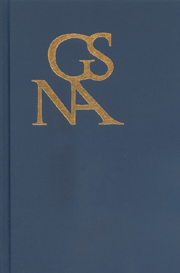Book contents
- Frontmatter
- Contents
- Presidential Address (December, 2004) Schiller vs. Goethe: Revisiting the Conflicting Reception Vectors of Heinrich Heine, Ludwig Börne, and Wolfgang Menzel
- Goethe's Mixed Media: The Entertainers in Jahrmarktsfest zu Plundersweilern
- Goethe's “Ilmenau” and the Origins of the Aesthetic State
- Familial Politics and Political Families: Consent, Critique, and the Fraternal Social Contract in Schiller's Die Räuber
- Paintings in Goethe's Wilhelm Meister Novels: The Dynamics of Erecting and “Eroding” the Paternal Law
- “Waldplatz,” “Wahlplatz”: Miszelle zur Golgatha-Konnotation einer Episode in Wilhelm Meisters Lehrjahre
- Shocks from a Sicilian Underworld: Gangi,“Gänge,” and a New Source for the “Mütter” in Goethe's Faust
- “Feuer brennen blau”: Rethinking the Rainbow in Goethe's Faust
- Cosmopolitanism and Weltliteratur
- “Von jedem öffentlichen Wirken in Deutschland ausgeschloßen”: Ein Brief Ottilie von Goethes an Sarah Austin (4. Aug. 1840)
- Book Reviews
Paintings in Goethe's Wilhelm Meister Novels: The Dynamics of Erecting and “Eroding” the Paternal Law
Published online by Cambridge University Press: 05 February 2013
- Frontmatter
- Contents
- Presidential Address (December, 2004) Schiller vs. Goethe: Revisiting the Conflicting Reception Vectors of Heinrich Heine, Ludwig Börne, and Wolfgang Menzel
- Goethe's Mixed Media: The Entertainers in Jahrmarktsfest zu Plundersweilern
- Goethe's “Ilmenau” and the Origins of the Aesthetic State
- Familial Politics and Political Families: Consent, Critique, and the Fraternal Social Contract in Schiller's Die Räuber
- Paintings in Goethe's Wilhelm Meister Novels: The Dynamics of Erecting and “Eroding” the Paternal Law
- “Waldplatz,” “Wahlplatz”: Miszelle zur Golgatha-Konnotation einer Episode in Wilhelm Meisters Lehrjahre
- Shocks from a Sicilian Underworld: Gangi,“Gänge,” and a New Source for the “Mütter” in Goethe's Faust
- “Feuer brennen blau”: Rethinking the Rainbow in Goethe's Faust
- Cosmopolitanism and Weltliteratur
- “Von jedem öffentlichen Wirken in Deutschland ausgeschloßen”: Ein Brief Ottilie von Goethes an Sarah Austin (4. Aug. 1840)
- Book Reviews
Summary
A PICTURE IS NOT JUST A textual ornament, and collecting is not just a matter of accumulating beautiful things.“This important theme [i.e., the art collection] in the symbolic texture of the novel [Wilhelm Meisters Lehrjahre] most probably occurred to Goethe in the autumn of 1793, as his mother began to break up the family home and to sell the objects familiar to him from his childhood, which he had seen for the last time on his way back from Mainz a few months before—among them his father's pictures.” The treatment of artwork in the novel not only provides a referential subtext to Wilhelm's struggle for identity in his very own Oedipal drama but also functions as an allegorical representation of the sociopsychological motivations and meanings attached to the activities of acquiring, displaying, and discussing art. In this context, paintings veil as well as expose characters' desire to embody, posses, and/or control the content expressed in their pictorial images. Above all, Wilhelm's passionate attachment to his favorite painting, Der kranke Königssohn, haunts the reader throughout the Lehrjahre and fuels scholarly interest to investigate nuances of signification informed by the intertextual complexity between painting and plot.
Even though this one painting stands out prominently due to the novel's multiple references to it, the examination of all artwork, including works of art that only seem to appear marginally, such as family portraits in private homes and historical allegories in the Pedagogic Province, exposes a layer of meaning that illuminates the relationship between art, literature, and Goethe's construction of human identity.
- Type
- Chapter
- Information
- Goethe Yearbook 13 , pp. 105 - 124Publisher: Boydell & BrewerPrint publication year: 2005



